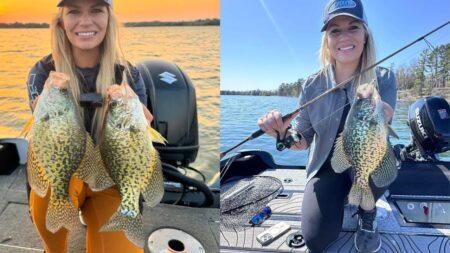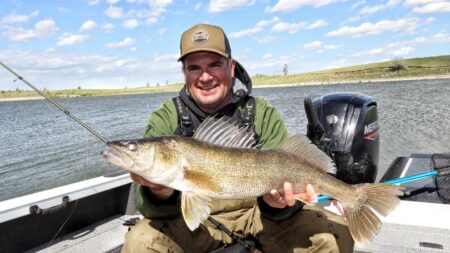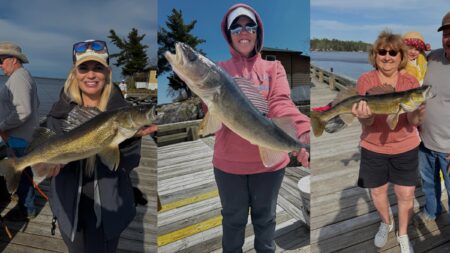Lake Oahe is a renowned walleye fishery located on the Missouri River in South Dakota. Chad Schilling of Asaska, South Dakota has been guiding on this massive reservoir his entire adult life. Few anglers have put as much time on Lake Oahe as Chad has. Besides a grind of a guide schedule, Schilling has also had several top tournament finishes on Lake Oahe. According to Schilling, the key to catching walleye right now on Lake Oahe during July and into August is simply covering water.
There have been a lot of hot, flat calm days on Lake Oahe recently and when the lake goes slick and flat, Schilling likes to move up shallower and fish faster… this has been the recent program for catching numbers of fish.
Schilling prefers a heavy 2 1/2-ounce bottom bouncer and often pulls bottom bouncers fast at speeds that range between 1.7 and 2.0 miles per hour. Schilling often finds fish back inside some of the larger bays and notes that the water is often dirtier back in the bays. Instead of using traditional metal bladed harnesses, Schilling prefers the Mack’s Smile Blades, propeller rigs or Butterfly Blades because they keep turning when the boat turns, and the inside rod slows down. Schilling doesn’t worry much about color citing gold, silver and red are his favorites but seldom finds that color is the big variable. Behind the beads, Schilling prefers to use a simple Aberdeen hook and threads the crawler up past the knot, pinching off the crawler about ½ an inch beyond the hook. This single long shank hook makes the overall presentation shorter with fewer misses and also seems to prevent small fish from getting gut hooked.
Covering water is the name of the game and the speed helps Chad cover water. “I seldom find turning around after I catch fish is the answer right now because it might take an hour or two for a few aggressive fish to move back into the spot. The fish are really scattered,” Schilling explains. Schilling’s overall program is simple. He runs back into the bays where the creek starts and takes a shoreline down to the mouth of the bay. When Chad gets done, he simply goes back up and comes down the other side. After hitting a few bays, Schilling usually has a bunch of walleyes rolling around in the live well for his clients. Schilling also adds that if you start catching smallmouth bass, perch, drum or catfish along some particular areas, you are in the right area because that is where the baitfish are located.
Schilling also incorporates Live Scope into his run and gun bottom bouncer program. “I pan with my trolling motor as I cruise along and look for fish ahead of the boat and simply aim wherever I mark fish. I typically just keep burning through the fish and don’t slow down or stop but my forward-facing sonar tells me if I have to angle shallower or deeper as I follow the contour,” adds Schilling.
As a general rule of thumb, Schilling observes that the fish are typically double the depth on the main lake versus where you find fish back in the bays. If you are finding fish in 7-8 feet of water back in the Grand River for example, expect to find fish in 14-16 feet of water when you leave the bay. Besides making the adjustment to fish deeper when leaving the bays, Schilling also starts using a lot more plain snells with just a simple slow death hook, traditional live bait hook or hook and single bead.
The productive mentality right now however is simply burning past as many fish as possible. Schilling notes that slower speeds will catch fish but the more ground you can cover, the more fish you go over through the course of the day. Cover water right now on Lake Oahe with these proven strategies to catch more fish this summer.





